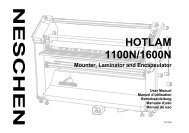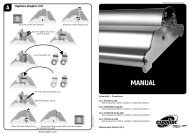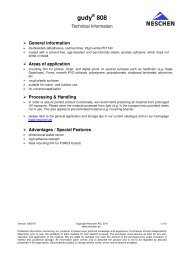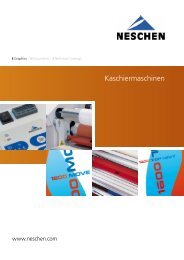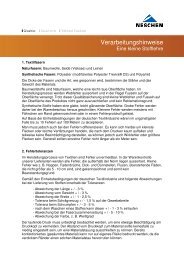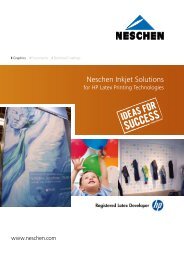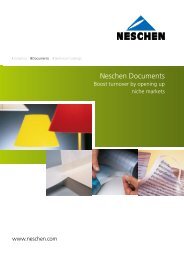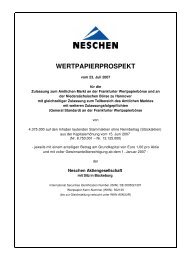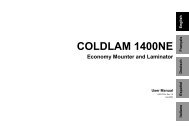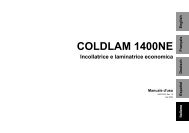Annual Report 2005
Annual Report 2005
Annual Report 2005
Create successful ePaper yourself
Turn your PDF publications into a flip-book with our unique Google optimized e-Paper software.
Notes relating to the consolidated annual accounts<br />
de all costs which can be directly or indirectly attributed to the manufacturing process. Financing costs and research costs are not shown as assets. Licences are<br />
written off by the end of the term of the licence. Five years has been taken as the useful life of software.<br />
Unscheduled depreciation is also applied to intangible assets specified on the closing date if the recoverable amount is below the continued acquisition and manufacturing<br />
costs. If the reasons for unscheduled depreciation in previous years should cease to apply, the value will be adjusted upwards.<br />
Intangible assets with an indefinite useful life will not be subject to the scheduled straight-line method of depreciation but will be checked regularly once a year<br />
to substantiate their value -and also at more frequent intervals if evidence shows that it is necessary. If necessary, depreciation will be applied and their value will<br />
be reduced to a lower recoverable amount. If the reasons for unscheduled depreciation in previous years should cease to apply, the value will be adjusted upwards.<br />
Tangible fixed assets<br />
Tangible fixed assets which have been used by the company for more than one year are valued at their acquisition or manufacturing costs less scheduled depreciation.<br />
The manufacturing costs of systems produced in-house include a reasonable share of the attributable overheads in addition to individual costs. Financing<br />
costs are not shown as assets within the acquisition or manufacturing costs. Investment grants received and independent investment grants are taken into account<br />
by deducting the amount of the grant from the acquisition or manufacturing costs of the asset in question.<br />
Depreciation of assets is only carried out using the straight-line method. Scheduled depreciation within the Group is based on the following useful lives:<br />
Buildings 50 years<br />
Fixtures and fittings 12-30 years<br />
Plant and equipment 6-12 years<br />
Machines 6-15 years<br />
Assets of negligible value are regularly written off in full in the year of acquisition.<br />
If evidence shows that it is necessary to reduce the value of assets and the recoverable amount is below the continued acquisition or manufacturing costs, then<br />
the assets will be subject to unscheduled depreciation. If the reasons for unscheduled depreciation should cease to apply, values will be adjusted upwards accordingly.<br />
Leasing<br />
The equitable ownership of leased objects is to be attributed to the lessee in accordance with IAS 117 “Leases” if the lessee is to retain all the main risks and<br />
rewards associated with the object (financial leasing). All other leases are classified as operating leases. If the equitable ownership is to be attributed to the<br />
Neschen Group, then the leased object will be shown as an asset at fair value or the current value of the lease payments if lower when the lease is concluded.<br />
Scheduled depreciation will take place over the useful life of the object or over the term of the lease if it is shorter, in accordance with comparable objects acquired<br />
as tangible fixed assets. Payment obligations arising from future lease payments will be shown as liabilities.<br />
Financial assets<br />
Financial assets include those which are kept by the Neschen Group for longer than one period for the purpose of capital gain, increasing the value of capital<br />
employed or building up business relations.<br />
If they do not relate to associated companies within the context of IAS 28 “Shares in associated companies”, financial assets are capitalised in accordance with<br />
IAS 39 “Financial instruments: recognition and measurement”. Financial assets are valued at (continued) acquisition cost or at fair value and entered on the trading<br />
day depending on how they are classified in accordance with IAS 39.<br />
Financial assets which are to be classified as being “available for sale” will be valued at acquisition cost when they are first entered in the accounts. If the fair<br />
values of these financial assets can be reliably determined during subsequent periods, then these will be used; if there are no active markets and the costs involved<br />
in determining fair values cannot be justified, then the (continued) acquisition costs will be shown. Borrowings will be classified as “advances and debts managed<br />
by the company” and consequently carried at continued acquisition cost. Financial assets which are designated as a secured transaction within a fair value<br />
hedge will be carried at fair value.<br />
Fluctuations in value resulting from financial assets from the “available for sale” category will be shown in the shareholders’ equity capital without affecting the<br />
result - if necessary taking account of deferred taxes. The amounts entered without affecting the result will not be included in the result for the period until the<br />
time of deduction or in the case of the sustained depreciation of the assets.<br />
Evidence of depreciation will be taken into account by applying appropriate unscheduled depreciation to the lower recoverable amount.<br />
Inventories<br />
Inventories are recognised at their acquisition cost, manufacturing cost or their net realisable value, according to whichever is the lower. Manufacturing costs include<br />
production and material overheads, depreciation and pro rata production-related general administrative costs as well as directly attributable costs. Fixed overheads<br />
are taken into account based on the normal utilisation capacity of production systems. Costs of production capacities not utilised (idle costs) are shown in<br />
the profit and loss account within the costs of performance realised. The value of inventories will be adjusted if acquisition or manufacturing costs go above the<br />
expected net realisable value or are dependent on range stocked.<br />
55




